An Assessment of the Spatial and Temporal Distribution of Soil Salinity in Combination with Field and Satellite Data: A Case Study in Sujawal District
Abstract
1. Introduction
2. Materials and Methods
2.1. Study Area
2.2. Geo-Reference Soil Sampling
2.3. Soil Properties Analysis Based on Spatial Mapping
2.4. Acquisition of Satellite Data and Classification of Imagery
3. Results and Discussion
3.1. Soil Textural Classes
3.2. EC and pH Analysis
3.3. Classification of Imagery Acquired from February 1990 and February 2017
3.4. Soil Salinity Indices
3.5. Correlation between Measured EC Data and Salinity Indices
4. Conclusions
Author Contributions
Funding
Acknowledgments
Conflicts of Interest
References
- Akramkhanov, A.; Martius, C.; Park, S.J.; Hendrickx, J.M.H. Environmental factors of spatial distribution of soil salinity on flat irrigated terrain. Geoderma 2011, 163, 55–62. [Google Scholar] [CrossRef]
- Kumar, N.; Singh, S.K.; Pandey, H.K. Drainage morphometric analysis using open access earth observation datasets in a drought-affected part of Bundelkhand, India. Appl. Geomat. 2018, 10, 173–189. [Google Scholar] [CrossRef]
- Zaman, M.; Shahid, S.A.; Heng, L. Guideline for Salinity Assessment, Mitigation and Adaptation Using Nuclear and Related Techniques; Springer: New York, NY, USA, 2018; Volume 3, pp. 43–53. [Google Scholar]
- Ennaji, W.; Barakat, A.; Karaoui, I.; El Baghdadi, M.; Arioua, A. Remote sensing approach to assess salt-affected soils in the north-east part of Tadla plain, Morocco. Geol. Ecol. Landsc. 2018, 2, 22–28. [Google Scholar] [CrossRef]
- Louis, T.; Group, B. Sindh Irrigation and Drainage Authority Preparation of Regional Plan for Left Bank of Indus Project on Protective Plantation of Mangroves in the Coastal Areas of Left Bank. Sindh Water Sector Improvement Phase-1 Report-2012,1-22. Available online: http://sida.org.pk/download/lbg/phaseIII/Volume%20I%20&%20II%20-%20Draft.pdf (accessed on 8 December 2019).
- Azabdaftari, A.; Sunarb, F. Soil salinity mapping using multitemporal landsat data. Int. Arch. Photogramm. Remote Sens. Spat. Inf. Sci. 2016, 41, B7. [Google Scholar]
- Babiker, S.; Abulgasim, E.; Hamid, H.S. Enhancing the spatial variability of soil salinity indicators by remote sensing indices and geo-statistical approach. J. Earth Sci. Clim. Chang. 2018, 9, 1–7. [Google Scholar] [CrossRef]
- Metternicht, G.I.; Zinck, J.A. Remote sensing of soil salinity: Potentials and constraints. Remote Sens. Environ. 2003, 85, 1–20. [Google Scholar] [CrossRef]
- Allbed, A.; Kumar, L.; Aldakheel, Y.Y. Assessing soil salinity using soil salinity and vegetation indices derived from IKONOS high-spatial resolution imageries: Applications in a date palm dominated region. Geoderma 2014, 230, 1–8. [Google Scholar] [CrossRef]
- Abbas, A.; Khan, S. Using remote sensing techniques for appraisal of irrigated soil salinity. MODSIM07-Land Water Environ. Manag. Integr. Syst. Sustain. Proc. 2007, 3, 2632–2638. [Google Scholar]
- Balakrishnan, P.; Saleem, A.; Mallikarjun, N.D. Groundwater Quality Mapping Using Geographic Information System (GIS): A case study of Gulbarga City, Karnataka, India. Afr. J. Environ. Sci. Technol. 2011, 5, 1069–1084. [Google Scholar] [CrossRef]
- Setianto, A.; Triandini, T. Comparison of Kriging and Inverse Distance Weighted (Idw) Interpolation Methods in Lineament Extraction and Analysis. J. Appl. Geol. 2015, 5, 21–29. [Google Scholar] [CrossRef]
- Behera, S.K.; Shukla, A.K. Spatial distribution of surface soil acidity, electrical conductivity, soil organic carbon content and exchangeable potassium, calcium and magnesium in some cropped acid soils of India. L Degrad Dev. 2015, 26, 71–79. [Google Scholar] [CrossRef]
- Mohammad, Z.-M.; Taghizadeh-mehrjardi, R.; Akbarzadeh, A. Evaluation of geostatistical techniques for mapping spatial distribution of soil pH, salinity and plant cover affected by environmental factors in Southern Iran. Not. Sci. Biol. 2010, 2, 92–103. [Google Scholar]
- Abbasnia, A.; Yousefi, N.; Mahvi, A.H.; Nabizadeh, R.; Radfard, M.; Yousefi, M.; Alimohammadi, M. Evaluation of groundwater quality using water quality index and its suitability for assessing water for drinking and irrigation purposes: Case study of Sistan and Baluchistan province (Iran). Hum. Ecol. Risk Assess. Int. J. 2019, 25, 988–1005. [Google Scholar] [CrossRef]
- Farifteh, J.; Farshad, A.; George, R.J. Assessing salt-affected soils using remote sensing, solute modelling, and geophysics. Geoderma 2006, 130, 191–206. [Google Scholar] [CrossRef]
- Asfaw, E.; Suryabhagavan, K.V.; Argaw, M. Soil salinity modeling and mapping using remote sensing and GIS: The case of Wonji sugar cane irrigation farm, Ethiopia. J. Saudi Soc. Agric. Sci. 2018, 17, 250–258. [Google Scholar] [CrossRef]
- Solangi, G.S.; Siyal, A.A.; Babar, M.M.; Siyal, P. Groundwater quality evaluation using the water quality index (WQI), the synthetic pollution index (SPI), and geospatial tools: A case study of Sujawal district, Pakistan. Hum. Ecol. Risk Assess. 2019, 7039. [Google Scholar] [CrossRef]
- Khan, M.A.; Alamgir, A.; Khan, A.; Shaukat, S.S.; Kazmi, S.J.; Qureshi, S.; Khanum, F. Appraisal of Climate Change Impacts on the Coastal Areas of Sindh Using Remote Sensing Techniques. Environ. Sci. 2015, 15, 1102–1112. [Google Scholar]
- Majeed, S.; Zaman, S.B.; Ali, I.; Ahmed, S. Situational Analysis of Sindh Coast-Issues and Options. Manag. Nat. Resour. Sustain. Futur. Agric. Res. Brief. 2010, 2, 1–23. [Google Scholar]
- Khuhawar, M.Y.; Brohi, R.O.Z.; Jahangir, T.M.; Lanjwani, M.F. Water quality assessment of Ramser site, Indus Delta, Sindh, Pakistan. Environ. Monit. Assess. 2018, 190, 492. [Google Scholar] [CrossRef]
- Bouyoucos, G.J. Directions for making mechanical analyses of soils by the hydrometer method. Soil Sci. 1936, 42, 225–230. [Google Scholar] [CrossRef]
- Heald, W.R. Methods of Soil and Plant Analysis With Special Reference to Strontium 90 Contamination; US Department of Agriculture: Washington, DC, USA, 1949.
- Pessoa, L.G.M.; Freire, M.B.G.D.S.; Wilcox, B.P.; Green, C.H.M.; De Araújo, R.J.T.; De Araújo Filho, J.C. Spectral reflectance characteristics of soils in northeastern Brazil as influenced by salinity levels. Environ. Monit. Assess. 2016, 188, 616. [Google Scholar] [CrossRef] [PubMed]
- Siyal, A.A.; Siyal, A.G.; Mahar, R.B. Spatial and temporal dynamics of Pai forest vegetation in Pakistan assessed by RS and GIS. J. Res. 2017, 28, 593–603. [Google Scholar] [CrossRef]
- Enderle, D.I.M.; Weihjr, R.C. Integrating Supervised and Unsupervised Classification Methods to Develop a More Accurate Land Cover Classification. J. Ark. Acad. Sci. 2005, 59, 65–73. [Google Scholar]
- Khan, N.M.; Rastoskuev, V.V.; Sato, Y.; Shiozawa, S. Assessment of hydrosaline land degradation by using a simple approach of remote sensing indicators. Agric. Water Manag. 2005, 77, 96–109. [Google Scholar] [CrossRef]
- Qingsheng, L.; Gaohuan, L.; Jun, Z. The indication function of soil type and soil texture and land type to soil salinization levels. Chin. Agric. Sci. Bull. 2008, 24, 297–300. [Google Scholar]
- González, F.J.; Basson, T.; Schultz, B. Final report of IPOE for review of studies on water escapages below Kotri Barrage. Unpubl. Rep. Int. Panel Expert Pak. 2005, 5, 1–43. [Google Scholar]
- Solangi, G.S.; Siyal, A.A.; Babar, M.M.; Siyal, P. Spatial Analysis of Soil Salinity in the Indus River Delta, Pakistan. Eng. Technol. Appl. Sci. Res. 2019, 9, 4271–4275. [Google Scholar]
- Faouzi, M.; Larabi, A. Problématique de la remontée, de la salinité et de la pollution par les nitrates des eaux de la nappe phréatique des Beni-Amir (Tadla, Maroc). Ingénieries-EAT 2001, 27, 23–36. [Google Scholar]
- Altaf, P.; Siyal, A.; Centers, U.S.; Studies, A. Climate Change: Assessing Impact of Seawater Intrusion on Soil, Water and Environment on Indus Delta Using GIS and Remote Sensing Tools Final Report 2018 Principal Investigator. 2018. Available online: https://www.researchgate.net/project/Climate-Change-Assessing-impact-of-seawater-intrusion-on-Soil-Water-and-Environment-on-Indus-delta-using-GIS-Remote-Sensing-tools (accessed on 8 December 2019).
- Yu, J.; Li, Y.; Han, G.; Guan, B. The Spatial Distribution Characteristics of Soil Salinity in Coastal Zone of the Yellow River Delta. Environ. Earth Sci. 2014, 72, 589–599. [Google Scholar] [CrossRef]
- Allbed, A.; Kumar, L. Soil Salinity Mapping and Monitoring in Arid and Semi-Arid Regions Using Remote Sensing Technology: A Review. Adv. Remote Sens. 2013, 2, 373–385. [Google Scholar] [CrossRef]
- Lea, C.; Curtis, A.C. Thematic Accur acy Assessment Procedures. Nat. Resour Rep. 2010, 1–90. [Google Scholar]
- Mahmood, A.; Sadiq, A.; Khan, S.I. Vulnerability of the Indus Delta to Climate Change in Pakistan. Pak. J. Meteorol. 2012, 8, 89–107. [Google Scholar]
- Bannari, A.; El-Battay, A.; Hameid, N.; Tashtoush, F. Salt-Affected Soil Mapping in an Arid Environment Using Semi-Empirical Model and Landsat-OLI Data. Adv. Remote Sens. 2017, 6, 260–291. [Google Scholar] [CrossRef][Green Version]
- Allbed, A.; Kumar, L.; Sinha, P. Mapping and modelling spatial variation in soil salinity in the Al Hassa Oasis based on remote sensing indicators and regression techniques. Remote Sens. 2014, 6, 1137–1157. [Google Scholar] [CrossRef]
- Tripathi, N.K.; Rai, B.K.; Dwivedi, P. Spatial modeling of soil alkalinity in GIS environment using IRS data. In Proceedings of the 18th Asian Conference on Remote Sensing, Kuala Lumpur, Malaysia, 20–24 October 1997. [Google Scholar]
- Singh, G.; Bundela, D.S.; Sethi, M.; Lal, K.; Kamra, S.K. Remote sensing and geographic information system for appraisal of salt-affected soils in India. J. Environ. Qual. 2010, 39, 5–15. [Google Scholar] [CrossRef]
- Siyal, A.A.; Lakhair, I.; Babar, M.M.; Siyal, P.; Solangi, G.S. Study of Soil, Water, and Cropping Pattern in Danastar Wah (Manchar Lake) Command Area Using Geospatial Tools. Mehran Univ. Res. J. Eng. Technol. 2018, 37, 655–668. [Google Scholar] [CrossRef]
- Mahar, G.A.; Zaigham, N.A. Examining Spatio-Temporal Change Detection in the Indus River Delta with the Help of Satellite Data. Arab. J. Sci. Eng. 2015, 40, 1933–1946. [Google Scholar] [CrossRef]
- Noroozi, A.A.; Homaee, M.; Farshad, A. Integrated application of remote sensing and spatial statistical models to the identification of soil salinity: A case study from Garmsar Plain, Iran. Environ. Sci. 2012, 9, 59–74. [Google Scholar]
- Bouaziz, M.; Matschullat, J.; Gloaguen, R. Improved remote sensing detection of soil salinity from a semi-arid climate in Northeast Brazil. Comptes. Rendus. Geosci. 2011, 343, 795–803. [Google Scholar] [CrossRef]
- Douaoui, A.E.K.; Nicolas, H.; Walter, C. Detecting salinity hazards within a semiarid context by means of combining soil and remote-sensing data. Geoderma 2006, 134, 217–230. [Google Scholar] [CrossRef]
- Fan, X.; Pedroli, B.; Liu, G.; Liu, Q.; Liu, H.; Shu, L. Soil salinity development in the yellow river delta in relation to groundwater dynamics. L Degrad Dev. 2012, 23, 175–189. [Google Scholar] [CrossRef]
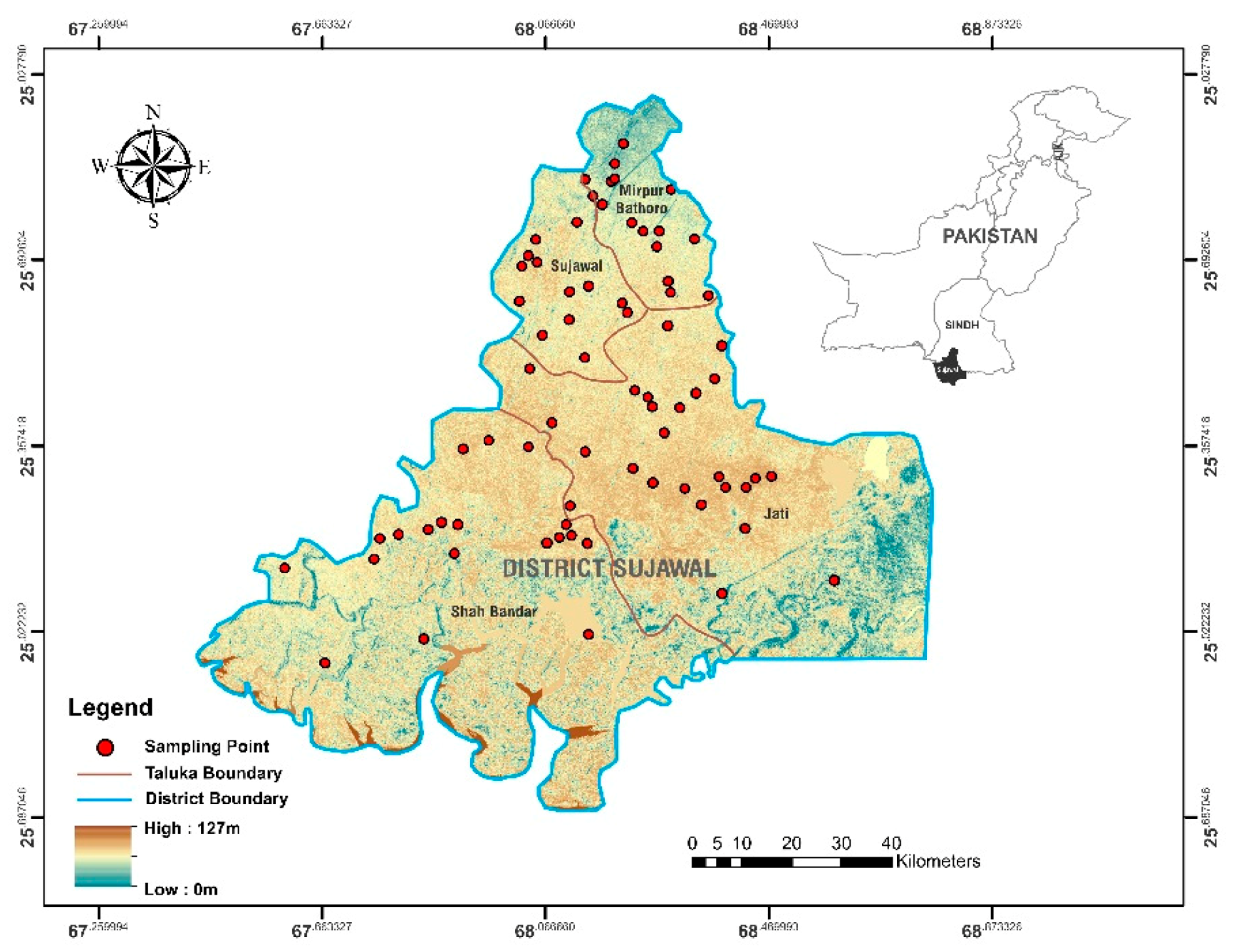

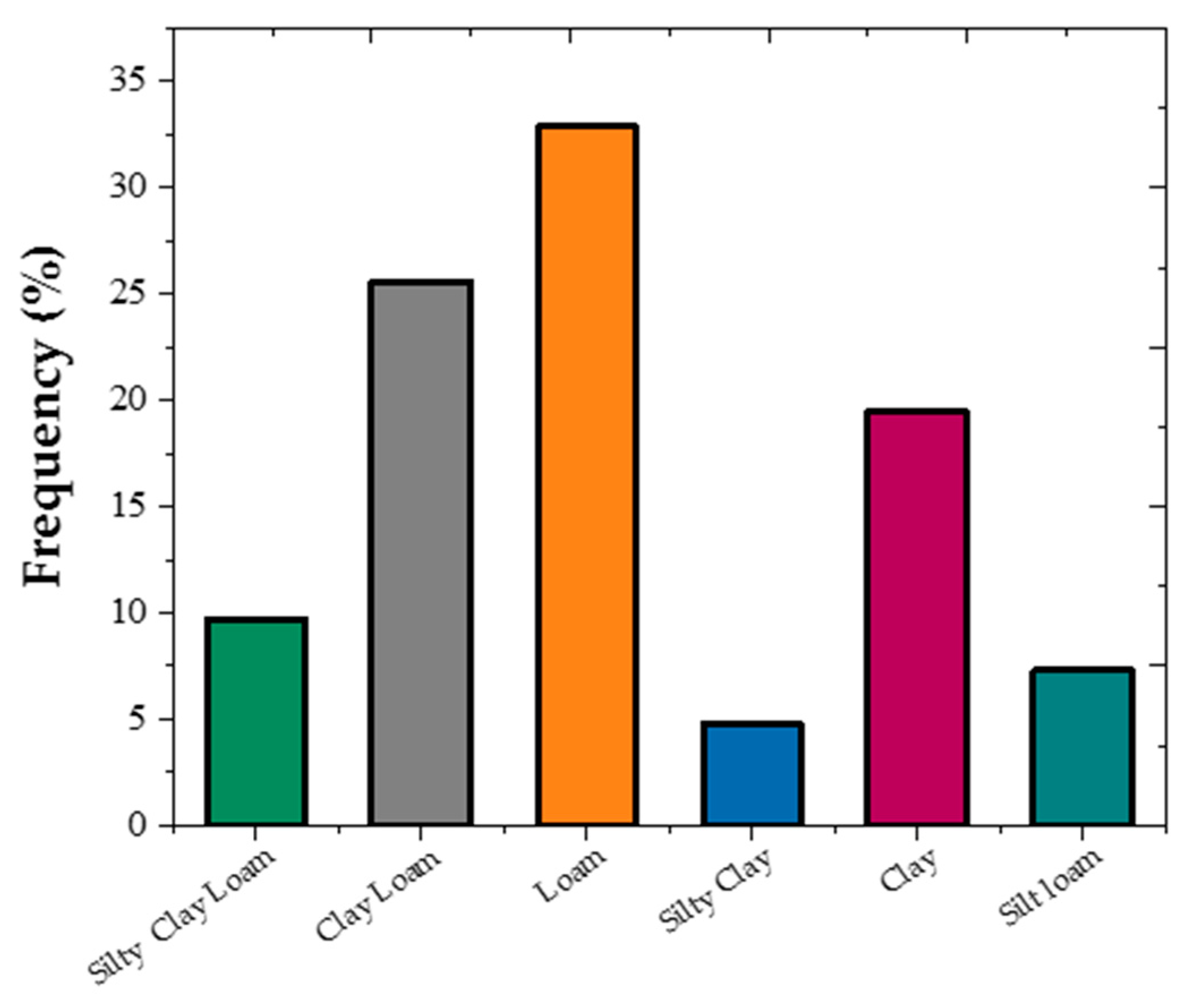
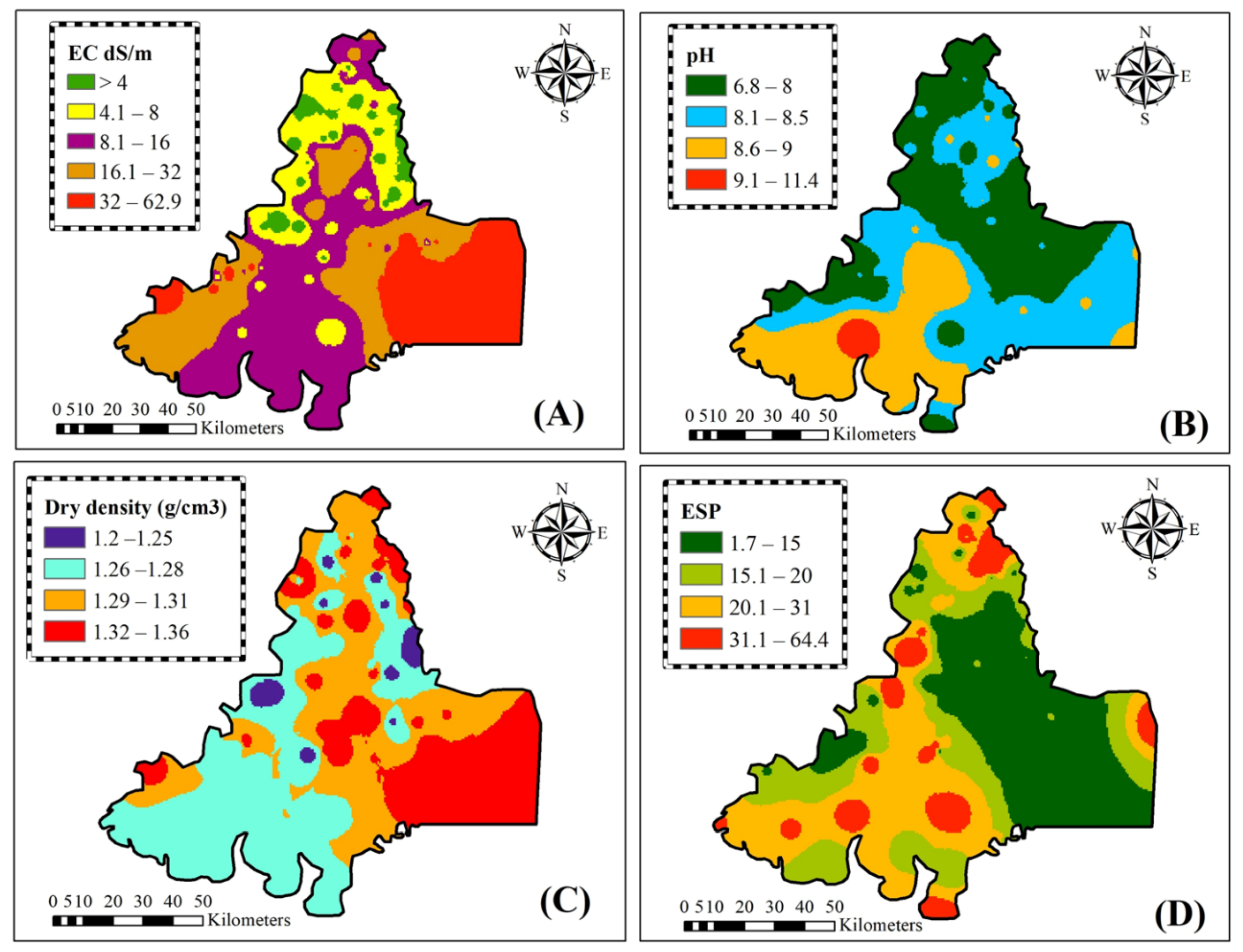
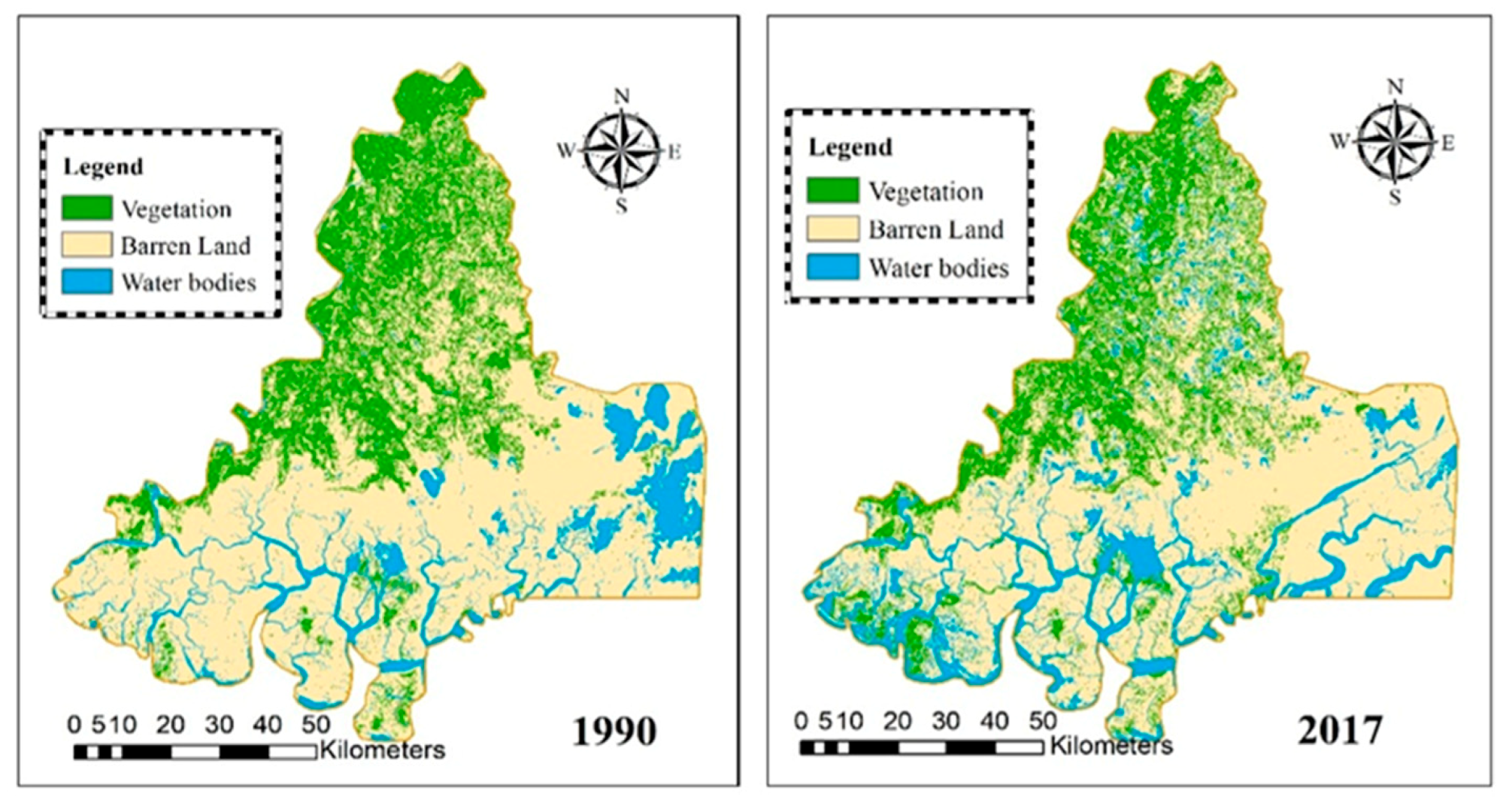
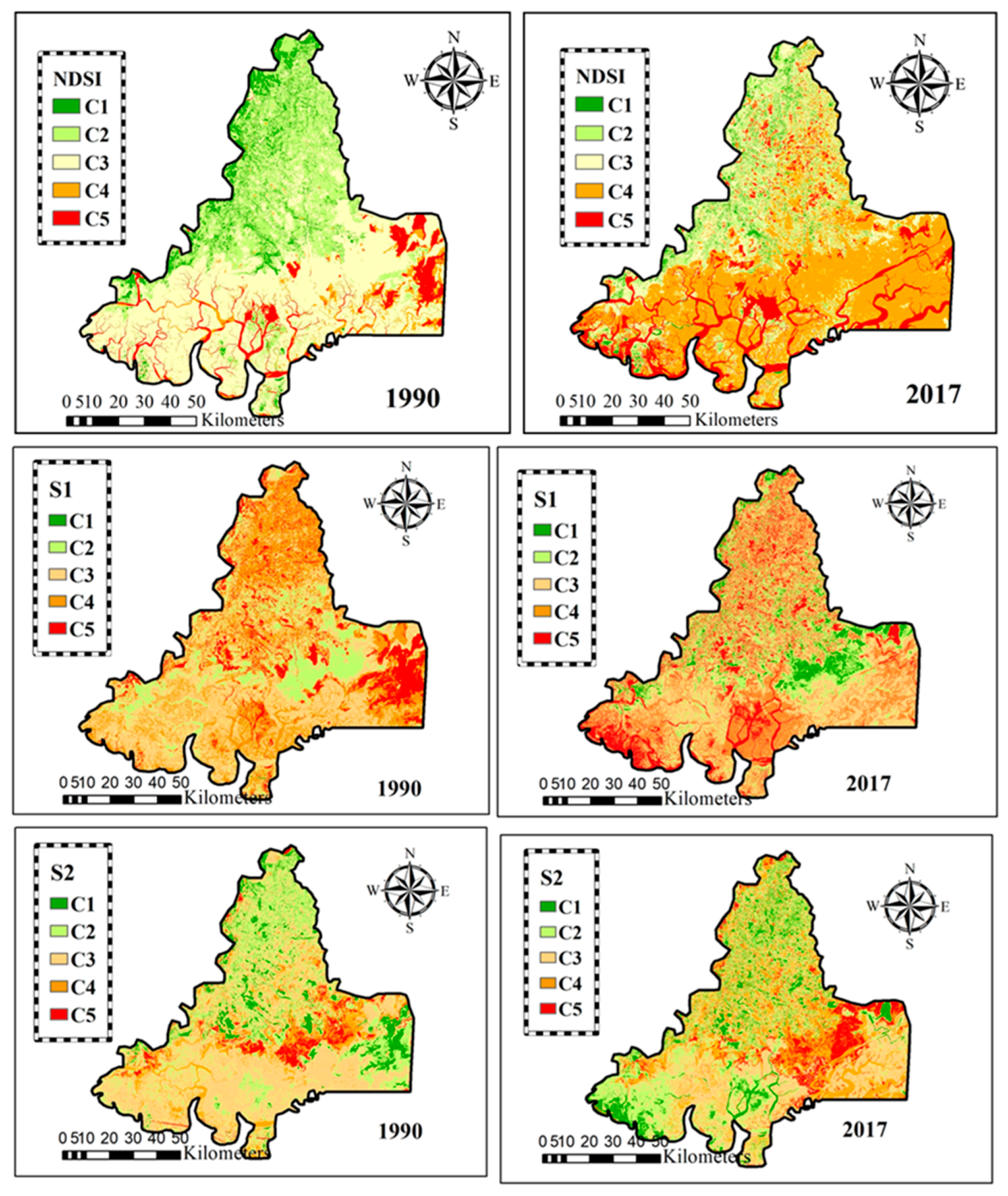
| S#No | Landsat Scene ID | Date of Acquisition | Path | Row | DOY | d | θs |
|---|---|---|---|---|---|---|---|
| 1 | LT515204319900321SPOO | 01/02/1990 | 151 | 43 | 32 | 0.98536 | 38.963608 |
| 2 | LT515104319900411SPOO | 10/02/1990 | 152 | 43 | 41 | 0.98680 | 37.253531 |
| 3 | LC81510432017051LGN00 | 28/02/2017 | 151 | 43 | 59 | 0.98817 | 46.110403 |
| 4 | LC81520432017042LGN00 | 18/02/2017 | 152 | 43 | 49 | 0.98835 | 43.506486 |
| Salinity Indices | Equations | References |
|---|---|---|
| Normal differential salinity index | NDSI = (R − NIR)/(R + NIR) | Khan et al. (2005) |
| Salinity Index 1 | SI = (B − R)/(B + R) | Abbas and Khan (2007) |
| Salinity index 2 | S2 = (G × R) / B | Abbas and Khan (2007) |
| Parameters | Min | Max | Average | STD | CI |
|---|---|---|---|---|---|
| Depth 0–20 cm | |||||
| EC | 0.50 | 46.6 | 14.2 | 14.8 | 1.20 |
| pH | 9.20 | 6.80 | 7.93 | 0.54 | 0.90 |
| ESP | 1.38 | 64.58 | 26.9 | 16.3 | 1.29 |
| Dry density | 1.19 | 1.35 | 1.27 | 0.04 | 0.02 |
| Depth 20–40 cm | |||||
| EC | 0.60 | 48.0 | 11.5 | 12.8 | 1.30 |
| pH | 7.10 | 9.10 | 8.02 | 0.48 | 0.80 |
| ESP | 5.24 | 65.9 | 27.5 | 16.22 | 1.29 |
| Dry density | 1.19 | 1.35 | 1.27 | 0.04 | 0.02 |
| Depths 40–60 cm | |||||
| EC | 0.70 | 41.8 | 9.80 | 10.87 | 1.42 |
| pH | 7.20 | 9.10 | 8.00 | 0.47 | 0.80 |
| ESP | 3.66 | 65.1 | 27.5 | 15.64 | 1.32 |
| Dry density | 1.17 | 1.34 | 1.26 | 0.04 | 0.01 |
| Land Utilization | Area (ha) (1990) | Area (ha) (2017) | Total Geographical Area (%) (1990) | Total Geographical Area (%) (2017) | Total Difference in Geographical Area (%) between 1990 and 2017 |
|---|---|---|---|---|---|
| Vegetation | 315,373 | 241,379 | 36.6 | 28 | −8.6% |
| Barren land | 453,884 | 492,222.3 | 52.7 | 57.1 | +4.4 |
| Water bodies | 92,163.2 | 127,819.5 | 10.7 | 14.9 | +4.2 |
| Total | 861,420.8 | 861,420.8 | 100 | 100 |
| Parameters | NDSI | S1 | S2 |
|---|---|---|---|
| EC | 0.879 ** | 0.934 ** | 0.874 ** |
| NDSI | - | 0.912 ** | 0.552 |
| S1 | - | - | 0.685 * |
© 2019 by the authors. Licensee MDPI, Basel, Switzerland. This article is an open access article distributed under the terms and conditions of the Creative Commons Attribution (CC BY) license (http://creativecommons.org/licenses/by/4.0/).
Share and Cite
Solangi, K.A.; Siyal, A.A.; Wu, Y.; Abbasi, B.; Solangi, F.; Lakhiar, I.A.; Zhou, G. An Assessment of the Spatial and Temporal Distribution of Soil Salinity in Combination with Field and Satellite Data: A Case Study in Sujawal District. Agronomy 2019, 9, 869. https://doi.org/10.3390/agronomy9120869
Solangi KA, Siyal AA, Wu Y, Abbasi B, Solangi F, Lakhiar IA, Zhou G. An Assessment of the Spatial and Temporal Distribution of Soil Salinity in Combination with Field and Satellite Data: A Case Study in Sujawal District. Agronomy. 2019; 9(12):869. https://doi.org/10.3390/agronomy9120869
Chicago/Turabian StyleSolangi, Kashif Ali, Altaf Ali Siyal, Yanyou Wu, Bilawal Abbasi, Farheen Solangi, Imran Ali Lakhiar, and Guiyao Zhou. 2019. "An Assessment of the Spatial and Temporal Distribution of Soil Salinity in Combination with Field and Satellite Data: A Case Study in Sujawal District" Agronomy 9, no. 12: 869. https://doi.org/10.3390/agronomy9120869
APA StyleSolangi, K. A., Siyal, A. A., Wu, Y., Abbasi, B., Solangi, F., Lakhiar, I. A., & Zhou, G. (2019). An Assessment of the Spatial and Temporal Distribution of Soil Salinity in Combination with Field and Satellite Data: A Case Study in Sujawal District. Agronomy, 9(12), 869. https://doi.org/10.3390/agronomy9120869








